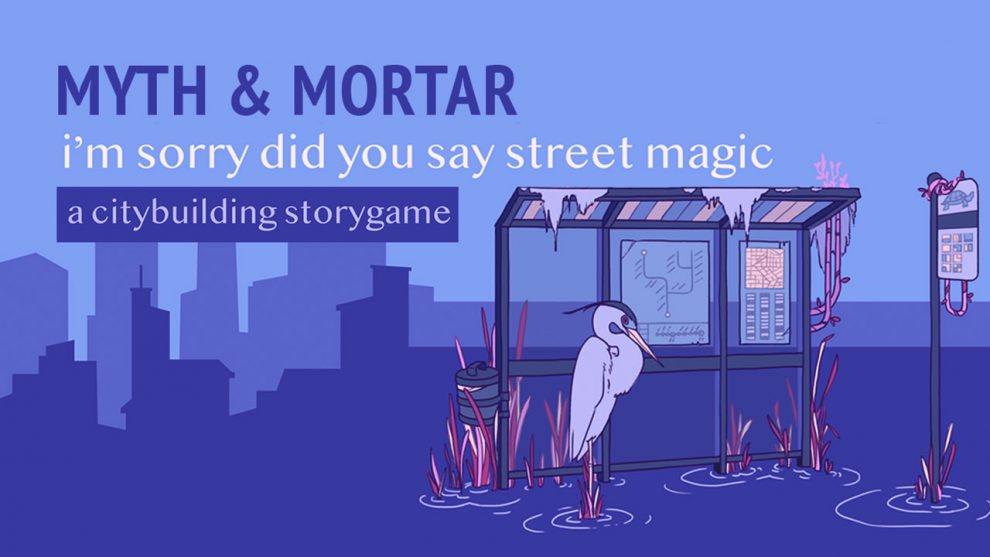Here’s my confession: i’m sorry did you say street magic won me over instantly… for the wrong reasons. See, a better reviewer might introduce the game by saying, like,
“This world-building storytelling RPG will impress everyone with its streamlined rules, breezy play, and spirit of friendly collaboration. As players work together to build a magical city, i’m sorry did you say street magic provides all the guidance they’ll need to tap into their imaginations and create something truly fun.”
And yes, all of that is true. But I had already fallen for the game the second I looked at its itch.io page, because:
1) Ooh, pretty colours, and
2) I love titles like Fall Out Boy songs and capitalization like bell hooks.
…And as much as I do love the title, we’ll abbreviate it to street magic in this review for ease of reading. Let’s take a look at how the game works.
Concepts: Laws of Magic
Street magic offers a pretty simple play system. The game is played with no Game Master: players share creative control, taking turns adding to the story.
On a player’s turn, they must contribute a new element to the city. The player describes a Neighborhood, Landmark, or Resident, jotting down some notes on a cue card. Each of these features have a couple traits that help establish what they are (such as a Reputation). They also have a kind of nested logic: Residents are associated with specific Landmarks, which in turn are associated with specific Neighbourhoods. This helps you get a sense of how things fit together as they enter the narrative.

Most turns are pretty brief: you’ll introduce your idea, say a few words about it, and write down its name along with any traits that the feature requires. Residents are a notable exception: when you introduce a Resident, you’ll also explore a little piece of their life with a scene where you act as the new Resident and your friends fill in as other characters. These scenes offer a fun chance to zoom in on the daily bustle of your city. When you create a Resident, you get to play with some of the ideas you’ve been dreaming up.
Once everyone has taken a turn adding something, the game pauses for an Event. These offer a chance to shake up the status quo and learn some of the perspectives of the people in the city. Events will often cause changes to the elements you’ve established as Residents, Reputations, and powers shift underneath the surface. Players are encouraged to cross out some old traits and write in new ones that came up during the Event.
After an Event, players take a chance to stretch their legs, discuss what’s happened, and shift focus for the next round. If the game’s story seems to be reaching a climax, this is also the point where you can decide to end the story or commit to another round.
What is Street Magic?
Part of the fun of street magic is that it doesn’t tell you what magic should look like, nor does it say what a city should look like. At first glance, the idea of creating a “magic city” may seem like it only has a few obvious answers. Yet the game leaves you a lot of room to breathe, which makes it feel surprisingly setting-agnostic. Sure, you could be a bunch of druids in some medieval village… but there’s nothing to stop you from exploring the darkened alleyways of a science-fantasy future. Maybe you’re a temporary community of witches that gather every year for a Mediterranean cruise. Maybe you’re an ant colony, casting spells of protection to ward off the coming of winter for just a little longer.

There are no in-text boundaries on what you’re allowed to explore. It would feel almost too open if it wasn’t for the help of the Compass; every round, one player must choose a theme, location, or concept that you’ll explore as a group as you add new elements to the city. The Compass only lasts for one round; it’s long enough to provide direction, but not so long that you start to run out of ideas.
Another thing that helps focus your city is the adjectives you’re asked to choose at the start of the game. There’s a big list of evocative adjectives in the rules. As a group, players choose three of these adjectives to define their city. It’s a lot easier to get started discussing ideas when you have a guiding vision that you chose at the start. I also love the list itself, which is filled with evocative words like faded, magnetic, and brittle.
Origins: Under the Microscope
Some of you may be familiar with the world-building game Microscope, by Ben Robbins. Street magic was originally published as a hack of Microscope, taking its basic elements and moulding them into a new form. This is how a lot of fantastic games have sprung up in the world of RPGs: Pathfinder, Blades in the Dark, and Star Crossed all began their lives as new takes on older works (D&D 3.5, Apocalypse World, and Dread, respectively).
And while street magic could not have come into being without Microscope before, it’s clearly its own game.
The most obvious difference between the two works is what they’ve chosen as the building blocks of their stories. In Microscope, players create history: everyone works together to add Periods, Events, and Scenes to the ongoing narrative. In street magic, you’re spending your turns creating a region: Neighbourhoods, Landmarks, and Residents are the ingredients on the table. While one game tells stories with time, the other tells stories with space.
What’s less obvious at first glance is that both of these designs are ultimately working towards the same thing. Whether in time or space, the elements everyone contributes each add a small piece of story and life to an evolving world. Both games do this in a curious and indirect way: the relationships between player contributions work together to imply a story. The narrative that emerges is so organic that it almost feels like an accident. While you may start out with grand ideas of architecture or history, it’s impossible not to find yourself weaving very human stories in-between. So both games construct stories in the same way in spite of how different the building blocks are.

A second difference is the way that these games imagine player dynamics, though part of this may have to do with the era in which Microscope was originally released.
In street magic, the designer (Caro Asercion) encourages an open dialogue throughout the play experience. Players are invited to ask each other questions, explore ideas, and use a communal sense of comfort and interest to build the story. While Asercion is clear that people should trust their co-directors and make bold individual choices, there’s a stronger undercurrent of consistent communication and out-of-game discussion. This, to me, feels natural; it’s an understanding that the players are sharing an experience and that open discussion is likely to lead to a story that everyone will enjoy.
Microscope, designed by Ben Robbins, is more prescriptive. There are rules for what you can and can’t say about a character someone else created. There’s advice right on the cheat sheet to “keep your ideas to yourself” when imagining the future of the story. There’s even a formalized process to resolve creative differences, including a voting round and a winner. In some ways it seems like overkill.
To understand why Robbins made these choices, we have to consider the context in which they were made. 2011 was only nine years ago, but at the time of Microscope’s release, a game with no Game Master was still pretty weird! While pioneers like Polaris (2004), Capes (2005) and Fiasco (2009) had established that the format could work, these games were experiments. As Robbins developed these formal rules, he was also trying to develop a framework that would make his game stable in a strange and unfamiliar paradigm.
But street magic is not without its own formal structures and the most notable new addition is the way that it incorporates safety tools into every aspect of play.
Safety: A Circle of Salt
One of the first things you see when you open up street magic is a handful of safety tools designed to keep everyone comfortable at the table. These tools serve to guide players towards an experience they can enjoy with explicit and clear communication, and they’re particularly useful here — without a single director or a predetermined story, there’s no way to know what tone or themes you’re going to explore before you get there.
None of these tools are brand-new, but they all feel at home in street magic. Rest Stops and Holds are used to discuss direction and take a stretch. Lines and Veils are used to set boundaries on topics players don’t want to explore.
Some may see tools like this as obstacles but in practice they allow for a more comfortable, natural play experience. They also let you explore some of the darker sides of your city without feeling like you’re stepping on anyone’s toes; when communication is explicit and encouraged the narrative can open up to places you might not have been brave enough to explore alone.
This spirit of communication is evident throughout the text of street magic and it’s always encouraging to see people going the extra mile to foster an inclusive, approachable experience.
Online Play: Spells with Range
Street magic was designed with an in-person context in mind, but the game is just as good online. Players can use a collaborative document like Google Docs or Conceptboard to record and visualize their contributions. Because I’m a huge nerd, I actually designed a spreadsheet that you can copy and use. Note that I’m not affiliated with the game and don’t get any kickback for this; I just like pretty colours and wanted something a little flashier than a blank page.
Closing Thoughts
If it’s not obvious already, I think street magic is cool as hell. It’s a rules-light, narrative-focused experience that has consistently given me fun and interesting stories. Even my goofiest cities — and there were some very goofy cities — had real moments of tension and emotional investment.
Of course, like all indie RPGs, this game may not be for everyone. The system is at its best when you have a group that invests in each other’s contributions, honouring the things each other created by weaving other people’s ideas into the narrative. The best thing your friends can give you is their ideas; the best thing you can do is play with them. As with improv, an attitude of “yes, and” lends itself well to a communal story.
There will be some people who protest that they “aren’t creative enough” for something like this. I honestly believe that most objectors will find they’re much more creative than they imagine themselves to be… but the attitude is still an obstacle in itself. Interestingly, a solution of sorts is in the works: Asercion is currently developing a supplement called easy streets. The supplement will offer quick-start cities as playbooks and prompts, which should help those who might feel a foundation of three adjectives isn’t enough to build a city on.
While street magic was part of a successful Kickstarter in February 2020, the game can still be purchased on Asercion’s itch.io page. Physical copies aren’t currently available to non-backers, but that may change as time goes on. I wouldn’t let that hold you back, though — i’m sorry did you say street magic is an absolutely charming game and one I hope you find just as spellbinding as I did.











Add Comment